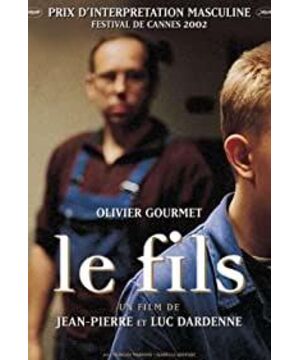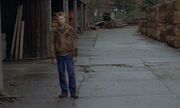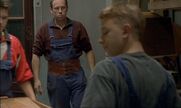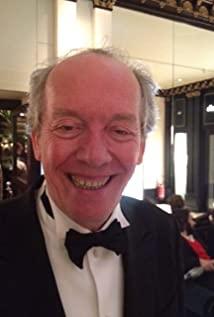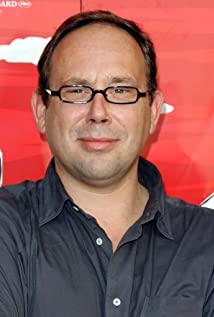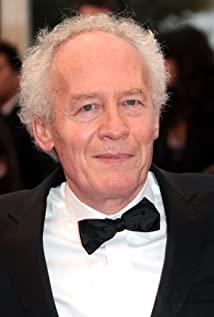"The Son of Others" has a more insidious and vague expression in all the Darney brothers' films. Looking at the film alone, it seems that it is just a story about the unfinished revenge of the father. The story is neither new nor the subject matter is very common. Stories of revenge and forgiveness are also common in literary and artistic works. Why did the Darney brothers have to try again and fall into the clichés of the public? The answer can only be: this seemingly ordinary film, its theme is not a story of revenge, but another mystery, which is not the first time it has appeared in the artistic control of the Darney brothers. There are also reflections in other works, that is, the dialogue and coordination between the people at the bottom and the social system, the confrontation and friction between the two, and the reconciliation and hope of the two, which they have been discussing all the time. The core of the Darney brothers' films.
The film uses hand-held follow-up photography for almost the whole process, and the camera is very close to the characters in the play, which is probably the first time in film history. In the film, the male protagonist Onevedo uses actions and expressions to express his heart, with very few lines. This method allows the audience to try to understand Ao's heart and take the role of the character to feel his painful experience. The Darney brothers added some avant-garde experimental attempts in this film, such as: shots that are always shaking, a large number of close-ups and close-ups of characters, the sounds of the natural environment that often appear, etc. They want to pass these attempts to test The tolerance and perception of the audience (including actors) enhance the real texture and effect of the film like a documentary. The film adopts a paragraph structure, which is similar to shooting in a "split shot" method. At first glance, it will feel a bit scattered, but after watching it a few times, the order of the paragraphs and the layers of progress will be clarified. In the film, Ao's identity is similar to that of the heroine Rosetta in "Rosetta", while Fu's identity is similar to that of Richter in "Rosetta". Why do you think so? Because the wrestling between the two at the end of the film is the same as the wrestling between Rosetta and Richter on the grass, the substantive meanings of the two films are similar or continuous. In view of this, the original intention of this film is not to tell a story of revenge, just like Rosetta is not revenge on Richter himself, almost the first half of the film (occupying nearly 1/3 of the film) The male protagonist's voyeuristic shots and action expressions are completed, which is not only to lay a solid foundation for the following plot, but also to vaguely express the cause of the trauma of the hero Olivier's psychology before and thus bring him pain, pain It is buried deep in the heart of the male protagonist Onevey. It does not need to be narrated through memories, emotional crying scenes, and music. That is not the style of the Darney brothers. Why is there so little music in Darney brothers' films? That's because there is often no music to accompany us in our lives. Isn't it better to restore the authenticity and coldness of life without music in the film? And most people accept the pain of life in forbearance. For example, the pain of Oneway in the film is forbearance, not the kind of heart-piercing. "The death of his son" is a fictional event, and Francis who "strangled his son" is actually a reference to the entire social system. When this social system proposes reconciliation and negotiation with the bottom people, that is, Francis (the social system) came to the juvenile When the center was preparing to learn woodworking (reconciliation negotiation) with Olivier (the bottom people), Olivier (the bottom people) was puzzled, uncertain and doubtful about this, which is shown in Olivier in the first half of the film. in the language of the voyeuristic and tentative lens.
Olivier has the pain of being hurt deeply by the F (the social system), and sometimes he has to tighten his cowhide belt to "restrain" his anger caused by this pain, but this pain is not caused by "self". "Son's unprovoked death", it is accumulated by the rude violations by Fu (an unreasonable social system) (similar to the "son strangulation" incidents), "the strangulation of the son incident" is just a metaphor or analogies, rather than actual events. Ao's ex-wife is also a victim of this. Every time her ex-wife appears, she wears red clothes, which is a symbolic expression of her desire for the "warmth" that the social system can bring her. Olivier's purpose of teaching woodworking at the juvenile center was actually to wait for the opportunity to have a dialogue and appeal with the unreasonable social system, and when the representative of this unreasonable social system, the juvenile delinquent Francis, came to the juvenile center, Olivier is hesitant to start a dialogue with him, he is considering the feasibility of such a dialogue, and the past is still disturbing him, his past dealings with and hurt by the social system, in the film It has been omitted, but we can get a glimpse of it from Olivier's dialogue and emotional reactions with his ex-wife. Olivier and his ex-wife had fought side by side in the struggle against the unreasonable system in the past, and later separated due to some conceptual differences. From her conversation with Olivier at the gas station, it can be seen that she is very afraid of the appearance of this Francis (unreasonable system), and also worried about Olivier's situation in the juvenile center, and Olivier is not like She stopped fighting the irrational system completely like that.
In the film, the first meeting between the ex-wife and Olivier is presented one by one through the dialogues, expressions, movements, positions and other aspects of the characters. It can be regarded as one of the rare and wonderful photography passages in the history of film. , Due to the differences between the two before, the ex-wife did not sit down and talk after entering the house. Olivier was a little nervous and embarrassed. The camera began to slowly pan from the ex-wife to Ao, and then from Ao to the ex-wife. There were three back and forth. The camera pans slowly, showing the psychological distance between the two and the embarrassment of the scene. After these few panning shots, the camera is aimed at the ex-wife, who is in the main position in the picture. , observing Ao's home and living environment, the expression of his ex-wife is meaningful, the dialogue between the two is intermittent, blunt and unnatural, giving people a sense of depression and dullness, the ex-wife is carefully testing, Ao is indifferently responding, the ex-wife's position is always in Under the door frame, she showed her cowardice and psychological defense. Ao used polite greetings, kept doing things, and walked back and forth to relieve her tension and embarrassment. It can be seen that the two had had violent conflicts before, and the current meeting was only a matter of time. Keeping the surface and pretending politeness, the ex-wife's visit was mainly to tell Ao that she wanted to forget the past and start a new life, and that she had a new life. At this time, the camera lens moved from the ex-wife to Ao's face, and fixed there. , focusing on expressing Ao's psychological reaction at the moment, the camera captured the sour expression on Ao's face, the ex-wife's words made Ao completely dead, and also touched Ao's heart. But it’s not over yet. The empty lunch box he wipes is a metaphor for his inner state of unresolved and empty, and then there is a slight pause in the sound (hand) of wiping the lunch box. Through his expressions and actions, the audience can feel him. The five flavors in my heart are mixed and turbulent. Then Ao rushed downstairs and asked why his ex-wife came to tell him about her pregnancy today. There was a reversal in the psychology of the characters in the film. Originally, Ao was still hesitating about whether to accept Francis as a disciple. The influence of the news of his ex-wife's pregnancy prompted him to make the decision to accept Francis as a disciple, implying that O would also start a new life, and it also showed that the arrival of Francis and the pregnancy of his ex-wife both happened on the same day. Coincidence in time, the visit of this ex-wife plays an important role in the film's turning point and ups and downs. It is the most exciting place in the whole film. From this, you can see the delicate and gentle side of the Darney brothers' film. Fine workmanship in craftsmanship!
From the above ex-wife's visit and the previous presentation of Olivier's peeping, hesitation and thinking, we can see a feature of this film: that is, try to simplify the dialogue as much as possible, and reflect the characters' actions and expressions through a large number of characters. Psychological activities, or relying on the external performance of the character's psychological activities to interact with the corresponding characters to promote the progress of the plot. This is a brand-new attempt in Darnay's film, and it is also a unique genre within the scope of film history. I call it a "psychological built-in film", which the Darney brothers should have considered when writing and directing. This kind of thinking, and they have worked hard on the "cadence" of the plot. They are testing the audience's acceptance of this type of film that relies on the expressions and actions of the characters to figure out his (her) psychological activities. They want to know the right Where are the limits and edges of this psychological shock for the audience (and for the actors)? For the Darney brothers, this is an interesting and experimental attempt, and this psychological impact is not created by strong events at the beginning, but is created by a well-spoken, step-by-step plot setting. Completed, of course, several turning points that make the plot change are hidden, from which we can see the process of gradually accumulating and finally releasing the psychological emotions of the characters in the film.
The Darney brothers always focus the camera's lens on the characters' heads and backs in the film, and create a sense of shaking and instability. This is especially used in the protagonist Olivier in the film. Its function is: to tell The whole story of the audience is Olivier's personal experience, just like an autobiographical novel, the characters usually use "I" as the first person, and Olivier's role is equivalent to the "I" in an autobiographical novel. "This character, let Olivier see, listen, think, and act in the film, focusing on the head to shoot more is to show his thoughts (thinking) and the thoughts (thinking) brought about by him. Facial expressions, allowing the audience to guess or experience Olivier's psychological activities and behaviors when encountering people (things) in the film, as well as the inner meaning displayed on his facial expressions, this design itself is to impress the audience Yes, just as autobiographical novels written in the first person "I" are especially touching! The instability of the camera lens is to tell the audience the hesitation and fluctuation of Ao's psychological activities, or to express a dangerous and uneasy atmosphere, such as the treatment of the camera when Ao and his ex-wife meet at the gas station.
The film directed by the Darney brothers also has some dramatic settings, rather than being entirely non-fiction. From "Son of Others", we can see the technique and context of its drama setting. The plot in the film changes from one piece to another, from the initial puzzle to the middle to give the audience an answer, and uses the three appearances of his ex-wife to change the plot. After meeting with his ex-wife for the first time, Ao accepted Francis. After Ao went to meet his ex-wife for the second time, the past (touch) of being hurt by the social system reappeared in his heart. In the play, Ao's attitude became cold and kept on guard. In the section where Fe measured the distance between his feet and O’s feet with a folding ruler, what Darnay wanted to show was not the numerical distance between the two measured by Fe, but the following: the distance between O and Fe The kind of psychological (and emotional) distance that is still relatively far away. In the mutual temptation at night, the two vaguely touched the secret past in their own (or the other party's) heart, but they were tacit, and the next paragraph was needed to reveal the secret. There is something cold, confrontational, and stiff and eccentric in this nighttime scene. Just like the previous meeting between the ex-wife and Ao, the central position was occupied by Fu, Fu (the unreasonable system) became the forced questioner (aggressor), and Ao (the lower class) became the forced answerer (violated). the person), and Fu’s questioning and facial expressions have a sense of coercion, impoliteness and non-negotiability. At one point, Ao was excluded from the camera, and only Fu’s words and actions were in the picture, while Ao only The purpose of this setting and composition is to show that in the "game" between the two, Ao (the people at the bottom) is in a weak passive position and is violated by Fu (the unreasonable system). Ao is in front of the camera. The disappearance also shows the lack or rejection of the autonomy and expression rights of the Austrian (the bottom people), and the meaning of these expressions also justifies the above-mentioned relationship between the Austrian (the bottom people) and the Fu (the irrational system). The existence of a relative relationship in the film.
In the next paragraph of Ogoff carrying a wooden board on a ladder, the two have physical contact. On the surface, it shows a physical contact incident caused by an accident when Ogoff was giving and receiving work, but the actual expression is A history of physical contact between Ao (the people at the bottom) and Fu (an unreasonable social system) in a certain fierce conflict in the past, and that fierce conflict made Fu also deeply hurt, and the old events are like a nightmare Usually it is torturing him, so he has to hold his head and shake his head. After the conflict, Ou used the waist belt to help himself not to forget the past, and also used it to suppress his full anger. It can be assumed that in In the conflict between Ao and Fu, which was omitted by the Darney brothers, Ao's body was injured and fell to the ground, and he may still be bedridden. That's why he used sit-ups to relieve the above two effects of this traumatic past, and this kind of sit-ups also constantly reminded him that there was always a time for the heavy injury to come to an end. The three unleashing of the belt and the two crunches in the film all happened after he had contact with Fu. Both were traumatized physically and mentally after experiencing the physical contact during that conflict. Here the Darney brothers subtly hide the true story of the two's past conflict, and instead express it in this veiled passage of end-to-end give-and-take.
In the next story, there is a dreamy atmosphere. Ao took the key from Fu's locker and sneaked into Fu's room. This motive stemmed from the moment when Ao saw Fu holding his head and shaking his head, Ao wanted to know why Fu did this. ? What is the reason behind this? Ao saw (experienced) his poor and rudimentary life in Fu’s living room. On the bedside table was the opened sleeping pills that Feu had been taking because he was disturbed by the past and had difficulty falling asleep. Fu’s home environment reflected Fu’s Life is not easy. Then, in the work scene of the two, Ao began to teach Fu how to make a tool box on the shoulder. Before that, Fu didn't have a tool box on the shoulder, which means that after experiencing Fu's home environment, Ao began to teach Fu to make a tool box on the shoulder. Fu's acceptance level changed, because Ao realized that life in Fu (an unreasonable social system) was also very difficult and not easy. It was smoothed and sanded with emery cloth. This small detail actually means that Ao is "grinding away" the psychological barrier between him and Fu. During the work, Ao has further learned about Fu's personal life. After work is over, I feel relaxed. Ao even offered to let Fu take his car when he got home, which shows that Ao's psychological acceptance of Fu has been greatly improved (it was cold before that). However, the sudden intrusion of the ex-wife made this change come to nothing. The fainting of the ex-wife shows how deeply she (also contains Ao) was hurt by the unreasonable system (Fu) in the past. At this time, Ao seemed to see the past. The past reappeared, and the heart was shaken again. You can see that Ao's attitude towards Fu has changed sharply. When the two people parted, Ao refused Fu's hand. Previously, Ao invited Fu to go to the lumber factory to get wood, which is preset for the next story. suspense.
View more about Le fils reviews


